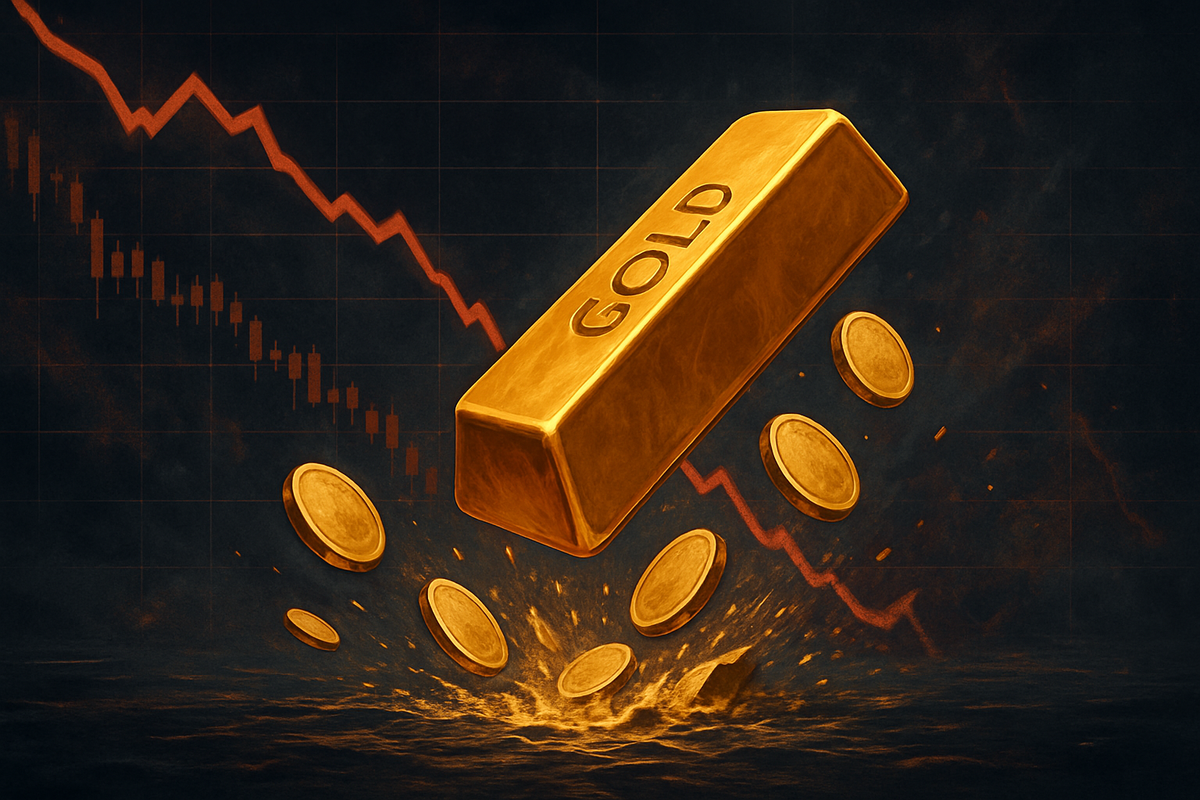Financial News
Gold Plunges in Steepest One-Day Drop Since 2013, Signaling Market Correction

Gold experienced a dramatic one-day decline on Tuesday, October 21, 2025, with prices plummeting over 6.3% to approximately $4,160 per ounce. This sharp retreat, which followed an extended rally that saw the precious metal reach an all-time high of $4,381.52 per ounce just the day prior, marks its most significant single-day percentage drop since April 2013. The sudden downturn has sent ripples through the commodities market, prompting investors to reassess the sustainability of gold's recent bull run and signaling a potential market correction.
The immediate implications are significant, with widespread profit-taking accelerating the fall and analysts pointing to an "overbought" market ripe for a correction. This abrupt shift in momentum challenges the perception of gold's unwavering safe-haven status, as capital appears to be rotating towards riskier assets amidst improving global sentiment. The decline has also impacted other precious metals and gold mining equities, highlighting interconnectedness within the broader market.
A Tumultuous Tuesday: Unpacking Gold's Sharp Retreat
The events of October 21, 2025, unfolded rapidly, catching many market participants by surprise. After scaling unprecedented heights, gold's ascent was abruptly halted, culminating in a substantial sell-off. The catalyst for this sharp reversal appears to be a confluence of factors, primarily aggressive profit-taking by investors who had benefited from gold's approximately 60% year-to-date surge. With the metal trading at record levels, many saw an opportune moment to lock in gains, triggering a cascade of selling orders.
Adding to the pressure was a strengthening U.S. dollar, which inherently makes dollar-denominated gold more expensive for international buyers, thereby dampening global demand. Furthermore, renewed optimism surrounding U.S.-China trade talks, with presidents reportedly scheduled to meet, contributed to an improved risk appetite across broader financial markets. As geopolitical tensions appeared to ease, the allure of traditional safe-haven assets like gold diminished, prompting a shift of capital into equities and other growth-oriented investments.
The timeline leading up to this moment saw gold on a relentless upward trajectory, driven by persistent inflation concerns, ongoing central bank buying, and various global uncertainties. This extended rally, which peaked on October 20, 2025, had established a robust bullish sentiment. However, the sheer speed and scale of Tuesday's decline underscore the market's underlying volatility and its susceptibility to rapid corrections after prolonged periods of growth. Key stakeholders, including large institutional investors, hedge funds, and individual traders, were all active participants in the accelerated profit-taking, contributing to the dramatic price action. Initial market reactions have been characterized by caution, with many analysts advising a wait-and-see approach to determine if this is merely a healthy correction or the start of a more prolonged downturn.
Companies Grapple with Golden Reversal
The sudden and steep decline in gold prices on October 21, 2025, has immediate and varied implications for public companies operating within the precious metals sector. Gold mining companies, in particular, are poised to experience significant impacts, largely negative in the short term. Major players such as Barrick Gold Corp. (NYSE: GOLD), Newmont Corporation (NYSE: NEM), and Agnico Eagle Mines Limited (NYSE: AEM) saw their stock prices tumble alongside the metal. These companies' profitability is directly tied to the price of gold, and a sustained downturn would squeeze their margins, potentially leading to reduced capital expenditure, slower exploration efforts, and even revised production targets. Investors in these equities faced substantial paper losses, with some experiencing double-digit percentage drops in their portfolios.
Conversely, companies involved in the fabrication and consumption of gold, such as jewelers or industrial users, could potentially see some relief from lower input costs, though this benefit might be offset by broader economic uncertainties that impact consumer demand. Furthermore, financial institutions with significant exposure to gold derivatives or those that provide financing to mining operations might face increased volatility and potential credit risks, depending on the severity and duration of the gold price slump.
The event also highlights the delicate balance between production costs and market prices. Companies with higher operating costs per ounce of gold produced will be disproportionately affected by a price decline, potentially rendering some marginal mines unprofitable. This could lead to asset write-downs or even divestitures in the longer term. For companies that hedged their gold production, the immediate impact might be mitigated, but those with unhedged exposure will feel the full brunt of the price drop. The ripple effect extends to the broader supply chain, impacting equipment manufacturers, service providers, and even local economies dependent on mining operations.
Broader Significance: A Shift in Market Dynamics
Gold's sharp decline on October 21, 2025, is more than just a single-day event; it represents a significant shift in broader market dynamics and investor sentiment. This correction follows a period where gold's role as a primary safe-haven asset had been amplified by persistent global uncertainties, inflationary pressures, and aggressive central bank purchasing. The sudden unwinding of these positions suggests that some of these underlying drivers may be losing their immediate potency, or at least being re-evaluated by the market.
The event fits into a wider trend of investors re-calibrating their risk exposure. The improved outlook on U.S.-China trade relations, even if preliminary, has a profound ripple effect, reducing the perceived need for defensive assets. This pivot towards riskier assets signals a renewed confidence in global economic growth, potentially benefiting equity markets and other cyclical commodities while dampening demand for gold. Competitors in the precious metals space, such as silver, platinum, and palladium, also experienced significant declines on the same day, underscoring the interconnectedness of the market and indicating a sector-wide re-evaluation rather than an isolated gold-specific issue.
Historically, sharp corrections in gold prices often occur after extended rallies, as seen in April 2013 when gold experienced its original steepest decline in 12 years, marking the end of a decade-long bull market. That event was driven by optimism about a recovering U.S. economy and the prospect of the Federal Reserve tapering quantitative easing. While the specific triggers differ, the current scenario shares parallels in the market's response to improving economic outlooks and a strengthening dollar. Regulatory implications could emerge if the volatility prompts calls for increased transparency in gold trading, although immediate policy changes are unlikely. This event serves as a stark reminder that even seemingly robust bull markets are susceptible to rapid reversals, influenced by shifting macroeconomic indicators and geopolitical developments.
What Comes Next: Navigating the Golden Crossroads
The path forward for gold and the broader precious metals market is now at a critical juncture. In the short term, market participants will be closely watching for signs of stabilization or further downward pressure. A rapid rebound might indicate that Tuesday's sell-off was indeed a healthy, albeit aggressive, correction in an otherwise bullish trend. However, continued weakness could signal a more protracted period of consolidation or even a bearish reversal, especially if the catalysts for the decline—a stronger dollar and improved risk sentiment—persist. Investors should brace for heightened volatility as the market attempts to find a new equilibrium.
Long-term possibilities remain diverse. While the immediate safe-haven appeal may have waned, underlying fundamentals such as ongoing central bank diversification, potential future inflationary pressures, and persistent geopolitical flashpoints could still provide a supportive floor for gold prices. However, if global economic growth truly accelerates and central banks adopt more hawkish stances, the opportunity cost of holding non-yielding gold could increase, leading to sustained outflows. Strategic pivots for mining companies might include focusing on cost optimization, deferring non-essential capital projects, and potentially increasing hedging activities to mitigate future price volatility.
Market opportunities could emerge for contrarian investors looking to buy gold or gold equities at a discount if they believe the long-term bullish thesis remains intact. Conversely, challenges will include navigating reduced investor confidence and potentially tighter financing conditions for exploration and development projects. Potential scenarios range from a swift recovery driven by renewed safe-haven demand or a weaker dollar, to a prolonged bear market mirroring the post-2013 period. The key will be monitoring global macroeconomic data, central bank policies, and geopolitical developments for clues on gold's next major move.
Comprehensive Wrap-Up: A Market Reassessment
Gold's steepest one-day decline since 2013 on October 21, 2025, represents a pivotal moment for the precious metals market, marking a significant correction after an extended and robust rally. The key takeaways from this event are clear: an "overbought" market was ripe for profit-taking, a strengthening U.S. dollar exerted downward pressure, and improving global sentiment – particularly around U.S.-China trade talks – diminished gold's immediate safe-haven appeal. This confluence of factors led to a rapid unwinding of positions, causing substantial losses for investors in gold and related equities.
Moving forward, the market faces a period of reassessment. While the dramatic drop might appear alarming, it could also be interpreted as a necessary cleansing of excessive speculation, potentially setting the stage for a more sustainable, albeit slower, growth trajectory. However, the event also highlights the inherent risks of extended rallies and the speed at which market sentiment can shift. The immediate future will likely be characterized by increased volatility as investors digest the implications and adjust their portfolios.
The lasting impact of this event will depend on whether the drivers of the decline prove temporary or structural. If global economic optimism continues to build and the dollar maintains its strength, gold may struggle to regain its recent highs. Conversely, any renewed geopolitical instability or resurgence of inflation concerns could quickly reignite demand for the yellow metal. Investors should closely watch key economic indicators, central bank communications regarding interest rates and quantitative easing, and developments in international trade relations. The coming months will reveal whether this sharp retreat was a mere blip on gold's long-term journey or a harbinger of a more significant change in its market standing.
This content is intended for informational purposes only and is not financial advice
More News
View More




Recent Quotes
View More
Quotes delayed at least 20 minutes.
By accessing this page, you agree to the Privacy Policy and Terms Of Service.



